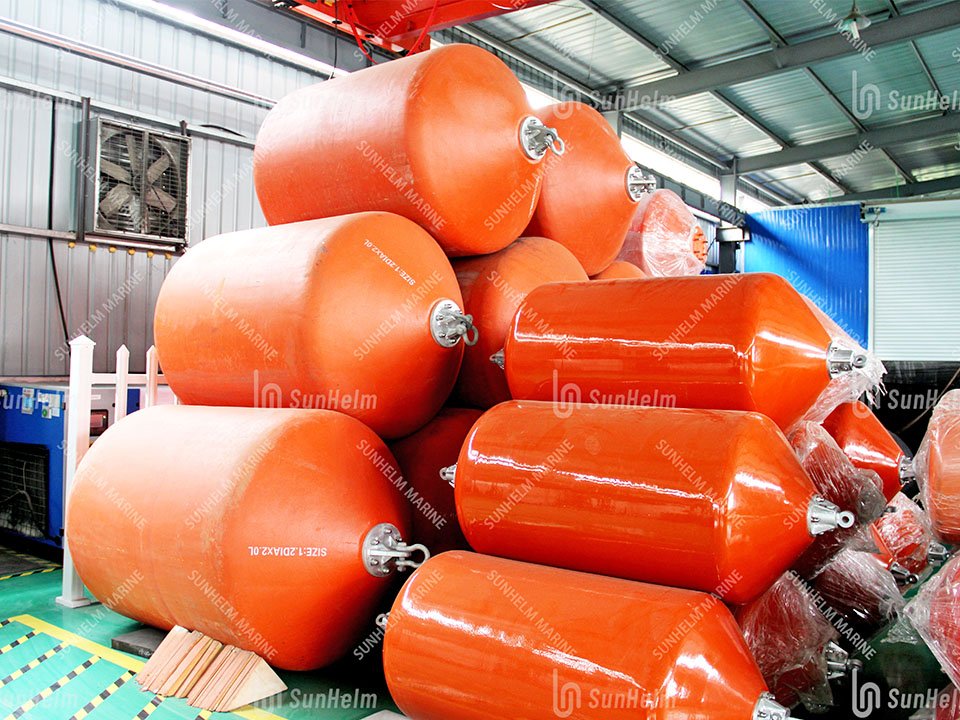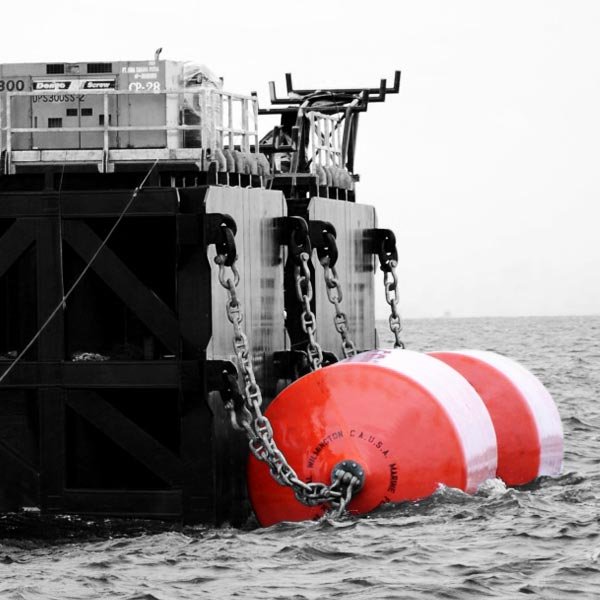The outer skin of foam fenders is usually made of polyurethane (PU) or polyurea elastomer, reinforced with nylon tire cord fabric. This skin is thick, wear-resistant, and non-marking. The fabric inside increases the tear and tensile strength.
Why This Topic Matters Now
At Sunhelm, we’ve seen many marine fender and ship fender users face high repair costs because of damaged fender skins. Imagine a heavy ship docking and hitting a weak fender. If the skin is too soft or thin, it can tear or even scratch the ship and dock. This can lead to accidents or delays.
As more ports operate around the clock, the demand for foam fenders for sale is growing. That’s why it’s important to know what fender skins are made of. Good skin materials make the fender last longer and keep ships safe.

Main Structure of a Foam Filled Fender
1. Closed-cell Cross-linked Foam Core
The foam inside is strong, keeps its shape even when damaged, and always floats.
2. Reinforced Polyurethane or Polyurea Skin
This outer skin stands up to seawater, sun, high and low temperatures, and oil. Nylon fabric inside the skin is placed in spiral layers to add strength and stop tears.
3. Chain and End Fittings Inside
Heavy-duty chains and metal parts are built into the fender to handle impact. These parts help spread the force and protect the skin from being cut or pulled.
Other questions
1. Want to know how foam fenders perform in real sea conditions?
We’ll explain how they work in rough seas, fast docking, and frequent port use.
2. Want to lower maintenance costs and increase lifespan?
Foam filled fenders don’t leak air. Even if the skin is cut, they keep working. They need very little maintenance and last for years.
3. Curious about how materials affect energy absorption?
You’ll see why foam fenders can absorb high impact and give low reaction force. This protects the ship and the dock from damage.
4. Want to know why Sunhelm stands out?
We’ll compare our marine fenders and ship fenders with others. Sunhelm uses nylon mesh for extra strength, and skin thickness of 32 mm or more for safety.
5. Want to avoid buying low-quality foam fenders for sale?
We’ll guide you in choosing the right fender size and material, based on your ship type and docking needs. That way, you won’t waste money on poor-quality products.
FAQ
Q1: What other materials are used for marine fender skins?
Besides PU or polyurea, some use synthetic rubber or plastic, but these don’t last as long.
Q2: Why choose foam filled fenders?
They never deflate, are easy to use, strong, and absorb energy well.
Q3: What’s the difference between polyurethane and polyurea skin?
Polyurea is harder and resists chemicals better. PU is more flexible and easier to shape. Sunhelm can offer both.
Q4: How do you install foam fenders?
You can hang them with ropes or chains. Use 2-point or 4-point mounting depending on your ship and dock setup.
Q5: How do you make the fender skin last longer?
Wash it often, avoid salt buildup, and don’t let sharp objects touch it. You can also upgrade to tire nets for extra strength.
Why Choose Sunhelm?
- Sunhelm focuses on marine fenders and ship fenders.
We use high-quality PU/polyurea skins and closed-cell foam cores. - Strong reinforced skins.
They resist sun, seawater, oil, and more. - Foam fenders for sale are fully customizable.
Choose your size, color, and extra protection like tire nets. - Trusted brand.
We care about material quality and give you the best value.
Quick Material Summary
| Part | Material Info |
|---|---|
| Foam Core | Closed-cell foam, stays floating, absorbs impact |
| Outer Skin | PU or Polyurea, with spiral nylon fabric |
| Skin Thickness | 32 mm or more, for safety and strength |
| Inner Structure | Heavy chains and metal parts |
| Add-ons | Tire mesh for more protection |
Ready to Learn More?
Want to compare product types, check material options, or get a free fender plan?
Contact Sunhelm today.
We’ll help you choose the right foam filled fenders to protect your ships and ports — for safety you can trust.


